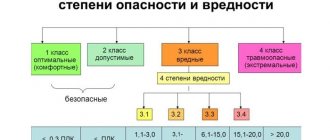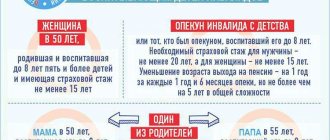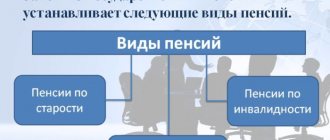Harmful to healthcare workers
Medical institutions often use part-time workers. If the staff is not fully staffed, then a number of functions and responsibilities are assigned to the existing staff in the clinic. This form of cooperation under a contract is provided for by law and regulated by the provisions of Article 60.2 of the Labor Code. Different jobs may be subject to different levels of “harmfulness.” In this case, how to calculate and pay the due compensation for harm from medical workers?
Article of the Labor Code of the Russian Federation No. 117 regulates the rules for issuing additional leaves. If the workplace assessment classifies it as at least 3.2, the medical worker is entitled to additional leave. Previously, according to the industry list, all employees of medical institutions had the right to 6.12 or 18.30 or more working days in addition to the main leave. Now this norm is not legitimate.
Compensation and benefits
If harmful factors in working conditions cannot be eliminated at a given enterprise, then employees are entitled to certain benefits. A minimum set of rights and compensations is established by law, which can be expanded by the employer’s decision. Additional privileges are prescribed in a collective or employment agreement, and are also enshrined in internal regulations.
Mandatory workers' rights include:
- Reducing working hours;
- Extension of annual leave;
- Passing periodic examinations in medical institutions at the expense of the employer;
- Accident insurance for the duration of work;
- Additional salary bonus;
- Providing special food or compensation corresponding to the amount of its cost;
- Assignment of early pensions.
Pension benefits
Early retirement is due to representatives of professions, a full list of which is fixed by law. Depending on the position and length of service, the employee receives the right to apply for a pension several years earlier than other citizens of the Russian Federation. It should be remembered that this benefit is provided only if there are additional contributions to the Pension Fund of the Russian Federation.
Submission and collection of documents for the assignment of pension payments can begin one month before termination of employment. In addition to standard documents, the Pension Fund of the Russian Federation will need to provide a certificate confirming harmful working conditions. The certificate is drawn up in free form at the place of work of the future pensioner and is certified by the seal of the organization and the signature of the manager.
If the harmfulness of professional activity at the enterprise is not confirmed, then employees can apply to the courts to order and conduct an extraordinary inspection. The results of court proceedings affirm the rights of citizens to early pension provision.
Harmful working conditions must be confirmed by expert assessments of a special commission. Employers should ensure maximum reduction and elimination of hazards through modern means that promote personal protection and improved equipment for employees.
Working citizens are advised to carefully monitor the proper fulfillment by employers of the obligation to pay additional contributions that allow early retirement. If the conditions for special deductions are not met, problems with the citizen’s social security will arise in the future. The company may cease to operate by the time the pension is issued, so it will be difficult to prove and collect the due amounts of money.
The procedure for registering pension benefits
In order to retire on preferential terms, the applicant will need to contact the territorial Pension Fund at the place of his immediate residence.
It is worth noting that today there are other options for submitting the required list of documents, namely:
- using a multifunctional center (MFC);
- through the official portal of State Services. To use this option, you must have a personal account registered on the website.
Current legislation allows for the possibility of obtaining a preferential pension by third parties, but for this it is necessary to issue a notarized power of attorney.
In order to minimize the period of registration of pension payments, the territorial bodies of the Pension Fund carry out a premature check of all necessary documents for those categories of citizens who have the right to apply for early well-deserved rest. In the process of this check and preparation of all documentation (checking whether everything is filled out correctly and whether there are any shortcomings), a so-called layout of the personal file of the future recipient of the pension benefit payment is formed.
The preferential pension payment, along with the general one, is calculated and assigned from the period when the entire package of necessary documentation was submitted.
Converting working days to calendar days
The duration of paid vacations for employees is calculated in calendar days (Part 1 of Article 120 of the Labor Code of the Russian Federation). According to the List, additional leave is calculated in working days. When calculating the total duration of annual paid leave, additional paid leaves are summed up with the annual main paid leave (Part 2 of Article 120 of the Labor Code of the Russian Federation). How to calculate the duration of the entire vacation (main plus additional) is stated in Letter of the Ministry of Labor of Russia dated 02/01/2002 N 625-ВВ.
The calculation of the duration of annual paid leave is as follows.
- The number of calendar days of the main vacation is counted from the start date of the vacation.
- Next, count the number of days of additional leave in working days based on a 6-day working week.
- Determine the date of the last day of vacation.
- The total vacation period is converted into calendar days.
Non-working holidays falling during the vacation period are not included in the number of calendar days of vacation. The amount of vacation pay is calculated according to the rules established by Art. 139 of the Labor Code.
Example 3. Let's use the data from example 1. It is necessary to determine the duration of the entire vacation of A.I. Ogonkova.
Solution. From the start date of the vacation - June 4, 2007, we count 28 calendar days, excluding the holiday - June 12, 2007. The main vacation ends on July 2, 2007. From the start date of the additional vacation - July 3, 2007, we count 13 working days according to the calendar of a 6-day working week. The last day of additional leave is July 17, 2007. The total number of calendar days from June 4 to July 17, 2007 is 44 days, and with the exception of June 12, 2007 - 43 days.
List of professions in the Russian Federation with hazardous working conditions
- chronic diseases that were acquired during activities in hazardous workplaces;
- incomplete/complete loss of ability to work;
- resulting fatal diseases.
In addition, there are positions in which work is regarded as harmful; they are specified in industry agreements or collective agreements of the organizations themselves.
According to Art. 57 of the Labor Code of the Russian Federation, in situations where the specifics of the work performed involve the presence of harmful or especially dangerous conditions, the following information is indicated in the employment contract:
- labor function (activities according to the position according to the staffing table, profession, specialization; it is necessary to clarify qualifications and a clear type of assigned work). And if compensation, benefits, and certain restrictions are also associated with the performance of a set of works for such a position (profession, specialization), their list should be indicated according to the names specified in the qualification directories;
- working hours when they diverge from the general ones approved by this employer;
- terms of payment (volume of tariff rate or salary (official salary), additional payments, allowances, incentive accruals);
- compensation for harmful and (or) dangerous conditions (characteristics of the working conditions of this workplace are prescribed).
Such conditions are accompanied by significant severity, as well as danger, risk of injury, factors that can cause chronic diseases, partial or complete loss of ability to work, even death.
These factors include: In addition, you should remember: the size of the preferential pension is calculated taking into account the length of service in general, i.e. the longer it is, the better it will be, the higher the salary, the better. The list of such professions for 2019-2019 includes more than 300 professions that fall under the heading of harmfulness with certain consequences in the form of benefits, pension supplements, and accounting for length of service.
All you need to do is leave your question in the form below.
List of professions in the Russian Federation with hazardous working conditions
This list contains mainly such professions, regular stay in conditions in which is harmful to a person. Therefore, it is reasonable to conclude: those who work in such harmful conditions have the right to retire earlier than the period prescribed in the usual situation. Workers and specialists employed on certain types of vessels of the sea, river, and fishing industry fleets have the right to receive pensions for their length of service.
- dust level;
- degree of gas contamination;
- high humidity;
- significant background radiation;
- lack of natural light;
- high degree of noise;
- activities with mobile machines, mechanisms, harmful chemical or bacteriological substances, etc.
Enterprises in Perm with the first hazard grid
Any profession can have a negative impact on human health. However, there are certain sectors of work where employees directly risk life and health. The list of professions with hazardous working conditions is established at the legislative level; such lists were compiled back in Soviet times and approved by the Cabinet of Ministers. For citizens employed in such industries, a number of social benefits are provided, including early retirement.
Currently, employers are using a more productive system of incentives and compensation for physical damage. In addition, there are special government programs aimed at supporting this category of employed citizens.
List of professions with hazardous working conditions according to the Labor Code of the Russian Federation in 2019
To apply for benefits and reduce the retirement age, an entry in the work book is sufficient.
Representatives of dangerous and hazardous professions are provided with a number of benefits that must be strictly observed by the employer. These include the following points: When faced with such offenses, employees can complain to the labor inspectorate or the prosecutor's office. As legal practice shows, in such situations the law is 100% on the side of the employee.
We describe typical ways to resolve legal issues, but each case is unique and requires individual legal assistance.
Determination of the degree of harmfulness
The following factors are considered standard indicators that determine the degree of harm:
- increased concentration of dust on the territory and indoors, which leads to its settling in the lungs, complicating the functioning of the respiratory system;
- poor-quality lighting, which has a depressing effect on the psyche and negatively affects the organs of vision;
- loud noise;
- radioactive and other wave radiation that can cause harm to health;
- constant vibration vibrations;
- high humidity and high temperatures;
- interaction with pathogens, dangerous viruses, chemically active components and highly toxic substances;
- difficult working conditions, intense work activity that can lead to mental disorders.
Of course, these are rather vague formulations, and many citizens can certainly classify their profession as harmful and dangerous. To avoid labor disputes and misunderstandings, there is a list of professions established at the state level, which takes into account all potentially dangerous areas of work.
A complete list of professions that are recognized as harmful and dangerous
According to the technical and legal standards in force in Russia, the following industrial sectors are recognized as harmful and potentially life-threatening:
- Mining;
- Metallurgical, related to ferrous and non-ferrous metals;
- Coke and chemical production of thermoanthracite substances;
- Those engaged in the production of generator gas;
- Dinas products;
- Chemical enterprises;
- Production lines for the production of ammunition and explosives;
- Oil and gas processing, including production of gas condensate, coal, shale;
- Metalworking;
- Electrical engineering, including repair of electrical devices;
- Production of radio equipment and complex electronics;
- Enterprises engaged in the production of building materials;
- Manufacturing products from glass or porcelain;
- Pulp and paper mills;
- Producing drugs, medicines and biomaterials;
- Healthcare enterprises;
- Printing;
- Transport and technical services;
- Research laboratories related to the study of radioactive radiation, any professions whose representatives are exposed to ionizing radiation;
- Nuclear industry and energy;
- Diving work;
- Employees directly involved with dangerous viruses and bacteria;
- Electric and gas welders performing work inside closed compartments, metal containers and tanks;
- Enterprises engaged in etching of metals in chemically hazardous solutions;
- Employees of workshops and production lines involved in cleaning metal surfaces with sandblasting machines using quartz sand;
- Mercury substations;
- Personnel employed at power plants and energy trains;
- Food industry;
- Organizations performing repair, restoration and construction work;
- Enterprises engaged in the provision of communication services;
- Film copying enterprises;
- Agrochemical complexes;
- Teaching staff involved in training personnel for the chemical industry.
Important! The definition of those employed in hazardous and hazardous industries includes representatives of professions who are directly involved in the performance of official duties associated with the threat of harm to health.
Moreover, the Decree of the Government of the Russian Federation dated February 25, 2000 No. 162 approved a list of heavy work and work with harmful or dangerous working conditions under which the use of women’s labor is prohibited, and the Decree of the Government of the Russian Federation dated February 25, 2000 No. 163 approved a list of heavy and hazardous work in which it is prohibited to employ persons under 18 years of age.
Do you need expert advice on this issue? Describe your problem and our lawyers will contact you as soon as possible.
Professions that give the right to early retirement
Early retirement guarantees not only employment in hazardous industries, but also a certain length of service devoted to this type of activity, as well as an individual pension coefficient of at least 30 for working years.
The procedure for early registration of pensions for such citizens is regulated by two lists. These are the so-called professions of lists 1 and 2, which give the right to early registration of pension benefits (Resolution of the Government of the Russian Federation of July 16, 2014 No. 665).
The first list identifies professions that can cause serious harm to health. This includes, for example, the following areas of work activity:
- rock development;
- ore beneficiation and roasting;
- production of ferrous and non-ferrous metals;
- specialists involved in the coke industry;
- employees associated with generator gases and chemicals;
- involved in the production of ammunition and explosives;
- oil and gas production and processing;
- metalworking specialists;
- manufacturers of building materials;
- workers engaged in the manufacture of products from glass, porcelain, artificial fibers;
- pulp and paper mill workers;
- representatives of motor transport enterprises;
- persons involved in printing;
- pharmacists;
- work with radioactive substances, specialists in the field of nuclear energy and industry.
To obtain a pension, representatives of the professions listed in the first list must fulfill the following conditions (clause 1, clause 1, article 30 of the Federal Law of December 28, 2013 No. 400-FZ “On Insurance Pensions”):
- Men - work for at least 10 years in a hazardous enterprise, retire at 50.
- Women who have worked for at least 7 years and 6 months at such enterprises receive a pension at 45 years of age.
Download for viewing and printing:
The second list includes less harmful professions, but long-term employment in this area can negatively affect health. These include:
- positions related to mineral processing;
- metallurgy;
- gas-electric welders;
- railway transport workers;
- persons employed in food industry enterprises;
- healthcare workers;
- peat extraction;
- employees of agrochemical complexes;
- communications enterprises;
- electrical engineers and specialists involved in the repair of electrical equipment;
- construction specialties.
The following conditions for early registration of pension provision apply here (clause 2, clause 1, article 30 of the Federal Law of December 28, 2013 No. 400-FZ “On Insurance Pensions”):
- Men - at least 12 and a half years of experience, retirement at age 55;
- Women - at least 10 years of experience, retirement at age 50.
Download for viewing and printing:
Important! Both lists do not require additional documentary evidence of employment in hazardous and life-threatening industries. To apply for benefits and reduce the retirement age, an entry in the work book is sufficient.
Harmful to healthcare workers
special assessments are recognized as safe or acceptable;
with the consent of the trade union.
whose work is associated with the danger of infection with Mycobacterium tuberculosis; AIDS prevention and control institutions working with radioactive substances and sources of ionizing radiation; psychiatric, drug treatment organizations; ambulance stations; organizations of the state sanitary and epidemiological service; blood transfusion stations; interacting with radioactive substances and sources of ionizing radiation. Depending on the positions held, additional paid leave is granted once a year to:
- 14-35 days - for health workers providing psychiatric care;
- 14-21 days - for health workers providing anti-tuberculosis care;
List of professions with hazardous working conditions
Today, there is a Government Decree according to which people working in hazardous conditions have the right to receive certain benefits. The first list was approved more than 60 years ago and applies to those people who began their working career under the Soviet Union, the second list of hazardous professions is intended for people working in modern Russia.
- High dust content in the atmosphere. In particular, the work of the lungs is hampered when dust settles in them. Moreover, the higher the content of harmful substances in the dust, the more destruction such breathing brings to a person.
- Poor quality lighting. In conditions of insufficient or inappropriate lighting, the human psyche is most sensitive and susceptible to disorder, as well as the mood and physical condition of a person.
- Loud noises.
- Harmful radiation.
- Working with harmful objects such as viruses and microorganisms.
- Working with harmful chemicals.
- Vibrations, dirt.
- Increased humidity levels.
- High or low temperature.
- Difficulty, duration and intensity of work.
Payment process
Any type of pension payment, including those accrued on preferential terms, is issued to its recipients for the current month.
In this case, you can choose any method of receiving :
- at the post office;
- in a banking institution;
- with the help of other private companies that carry out their work in this direction.
If recipients of pension payments have expressed a desire to change the method of receiving funds, it is necessary to notify the Pension Fund employees about this.
Work experience giving the right to additional leave
The length of service that gives the right to additional leave includes only the time actually worked in harmful or dangerous working conditions (Part 3 of Article 121 of the Labor Code of the Russian Federation). Since the procedure for calculating length of service for annual basic paid leave and the procedure for calculating length of service for additional leave for work with harmful and (or) dangerous working conditions are different, the working years for which these leaves are granted, as a rule, do not coincide. The length of service giving the right to leave is calculated separately for the annual main paid leave and additional (clause 9 of the Instructions).
Perhaps, during the working year, the employee worked in different workshops, performed different duties, for which they are provided with additional leave of varying durations. In this case, the time worked in hazardous conditions should be calculated for each job separately (clause 11 of the Instructions). The time worked in hazardous working conditions includes only those days on which the employee was actually employed in these conditions for at least half of the working day. If the List contains the indication “permanently employed” or “permanently working”, then the days worked in hazardous working conditions are counted as days in which the employee was actually employed full-time in these conditions (clause 12 of the Instructions).
To calculate the length of service (the number of full months) giving the right to additional leave, it is necessary to divide the total number of days of work in harmful and (or) dangerous working conditions by the average monthly number of working days. In this case, the balance of days that is less than half the average monthly number of working days is discarded, and the balance of days that is half or more of the average monthly number of working days is rounded up to a full month (clause 10 of the Instructions). The average monthly number of working days is determined by dividing the number of working days in the corresponding year according to the working calendar established by the internal labor regulations by 12 months.
Example 1. Gas welder A.I. Ogonkov went to work in a workshop for the production of semiconductor materials (germanium and silicon) in the area for repair, adjustment, installation and maintenance of equipment. When working in this profession throughout the entire working year, the additional leave is 12 working days (IV - metallurgical production, B - non-ferrous metallurgy, No. 579 of the List). He started work on July 10, 2006.
From September 18, 2006 to November 30, 2006 A.I. Ogonkov worked as a gas welder in a loparite concentrate processing shop. For such work throughout the entire working year, the additional leave is 18 working days (IV - metallurgical production, B - non-ferrous metallurgy, No. 498 of the List). Then, on December 1, 2006, he returned to his previous workplace.
Since June 4, 2007, the employee has been provided with:
- regular annual paid leave (28 calendar days);
- additional leave on the basis of Part 1 of Art. 117 Labor Code.
What should be the duration of additional leave in working days if it is known that the employee has a 5-day working week?
Solution. Let us determine the number of working days worked at each workplace.
For the period from July 10 to September 17, 2006 - 50 working days, from December 1, 2006 to June 3, 2007 - 121 working days. In total, the employee worked for 171 working days under conditions for which he was entitled to additional leave of 12 working days. During the period from September 18 to November 30, 2006, the employee worked 53 working days.
The average monthly number of working days in both 2006 (248 working days: 12 months) and in 2007 (249 working days: 12 months) is 21.
Let's determine the number of full months worked at each workplace:
- 8 months (171 work days: 21 work days) - at the site for repair, adjustment, installation and maintenance of equipment;
- 3 months (53 working days: 21 working days) - in the loparite concentrate processing workshop.
Let us determine the number of days of additional leave provided for each “harmful” workplace:
- 8 days (12 days: 12 months x 8 months) - for work on the site for repair, adjustment, installation and maintenance of equipment;
- 5 days (18 days: 12 months x 3 months) - for work in the loparite concentrate processing workshop.
The total duration of additional leave is 13 working days (8 days + 5 days).
If an employee has the right to receive additional leave due to harmful working conditions for several reasons, then leave is granted only for one of them (clause 18 of the Instructions).
Example 2. A porter works in a radon clinic at an altitude of 2100 m above sea level. How to calculate the duration of additional leave?
Solution. Calculation of additional leave.
Did you like the material?
Subscribe to the daily newsletter so you don't miss interesting materials:
FOUNDER AND EDITOR: JSC Publishing House "Komsomolskaya Pravda".
The online publication (site) is registered by Roskomnadzor, certificate El No. FS77-50166 dated June 15, 2012. Editor-in-Chief - Sungorkin Vladimir Nikolaevich. The chief editor of the site is Olesya Vyacheslavovna Nosova.
Posts and comments from readers of the site posted without editing. The editors reserve the right to remove them from the site or edit them if these messages and comments constitute an abuse of freedom of media or a violation of other legal requirements.
Perm is a large diversified, scientific, cultural and logistics center of the Urals. Administrative center of the Perm region.
The city was founded in 1723. From 1940 to 1957 it was called Molotov.
987.2 thousand people live in Perm.
The distance from Perm to Moscow is 1580 km.
Industry of Perm, enterprises and factories of Perm
In terms of industrial production, Perm ranks first in the Urals; more than 35% of the region's industrial output is produced in the city. The leading industries in Perm are the electric power and fuel industries, which account for 12% and 19% of total industrial production, respectively. Mechanical engineering, chemistry and petrochemistry, woodworking and the food industry are well developed.
Electric power industry
• Kama HPP – part of the Volga-Kama cascade of HPPs, HPP capacity – 519 MW.
Oil and gas refining enterprises of Perm • LLC “LUKOIL-Perm” - an oil and gas production enterprise; • CJSC "Uralgazservice" is one of the largest gas distribution companies - an enterprise that supplies gas to industrial and municipal enterprises.
Mechanical engineering and metalworking
• Iskra-Turbogaz LLC is an enterprise specializing in the production of Ural gas pumping units, equipment for the gas industry and energy; • LLC - an enterprise for the production of hydraulic screw downhole motors and other equipment for the oil and gas industry; • OJSC “Permsky” is a large, wide-profile enterprise producing equipment for various industries; • JSC “Metallurgical – production of sheet metal; • Tochlit LLC is a foundry enterprise.
Forestry and woodworking industry in Perm
• OJSC "Perm House-Building Plant" - production of furniture, lumber, window and door blocks; • OJSC “Lumber “Krasny Oktyabr”” is a large enterprise in the woodworking and forestry industry of the Perm region; • Perm Cardboard LLC - production of cardboard, shipping containers, boxes, corrugated paper.
Chemical industry Perm
• ZAO Sibur-Khimprom - a large petrochemical complex; • JSC "Halogen" is one of the largest enterprises in the chemical industry of the Russian Federation; • OJSC Kamtex-Khimprom - production of organic chemicals; • JSC Henkel-Pemos - production of household chemicals.
Industrial companies, suppliers and manufacturers of the Perm region. In total, more than 200 industrial companies from the Perm region are represented in the Supplier Catalog of the Metaprom.ru portal.
Article posted: 03 Nov 2009 Last edited: 28 Jan 2015
Related topics:
- Harmfulness grid 2 The procedure for applying for early retirement when working in hazardous working conditions (List 2) Many of our citizens who...
- 2 grid of harmfulness for retirement What is included in harmful experience? Under the common phrase “harmful experience” today in the field of pension provision it is accepted ...
- Travel for labor veterans The title of labor veteran is awarded to a person for many years of work and labor merits. Rank and certificate of veteran...
Retirement according to lists 1 and 2 with full and incomplete preferential service
To assign an early old-age insurance pension to employees in Lists 1 and 2, three main conditions are legally defined:
- reaching the established retirement age;
- availability of full insurance experience;
- duration of special (preferential) experience.
The conditions for early retirement by age for men and women in accordance with Lists No. 1 and No. 2 are shown in the table:
| Assignment condition | Men | Women |
| According to List No. 1 | ||
| Retirement age | 50 years | 45 years |
| General insurance experience | at least 20 years | at least 15 years |
| Special experience* | 10 years | 7.5 years |
| According to List No. 2 | ||
| Retirement age | 55 years | 50 years |
| General insurance experience | at least 25 years | at least 20 years |
| Special experience * | 12.5 years | 10 years |
| * If these persons have worked in dangerous and harmful jobs (according to List No. 1) or hard work (according to List No. 2) for at least half of the period established above and have the required length of insurance (total) length of service, they will be granted an early pension with a reduction in retirement age : | ||
| Reducing the age according to List No. 1 | for one year for each full year of benefit work | |
| Reducing the age according to List No. 2 | for one year for every 2.5 years of benefit work | for one year for every 2 years of preferential work |
A prerequisite for early retirement is the presence of at least 30 pension coefficients (IPC).
Example
The man has 4 years of experience under List No. 1, 9 years under List No. 2 and 26 years of total insurance experience. He does not have the right to retire in old age according to List No. 1. If you have “pure” experience according to List No. 2 (9 years), the right to a pension arises at 57 years of age. When added to the periods of work in List No. 2, the periods of work in List No. 1 result in a preferential length of service equal to 13 years. This gives the right to retire at 55 years of age.
Last changes
Our experts monitor all changes in legislation to provide you with reliable information.
Bookmark the site and subscribe to our updates! List No. 2, section 2070100a-11486 Wire drawing machines. And who are you? For men 55 years old, length of service in a preferential position is 12 years 6 months. For women 50 years old, 10 years of experience in a preferential position.
You have successfully subscribed.
Now all new paid questions will be sent to you by email.
You can unsubscribe in your Notification Settings © Yustiva All rights reserved 2017-2019 With the support of online chats Log in as the author of the question to rate the lawyer’s answer and/or add a comment to it. Log in as the author of the question to rate the lawyer's answer and/or add a comment to it.
Time is up
If you have any questions, you can consult for free via chat with a lawyer at the bottom of the screen or call by phone (consultation is free), we work around the clock.
The time allocated for editing has expired.
Thank you!
Our moderator will review your complaint shortly. GOVERNMENT OF THE RUSSIAN FEDERATION DECISION of February 25, 2000 N 163 Moscow
Classification and list of professions with hazardous working conditions
- Dust. The high concentration of dust in the air has a harmful effect on the human respiratory system. In industries where this factor is higher than normal, special equipment and protective respirators are used.
- Lighting. The degree of illumination that deviates from generally accepted standards has a detrimental effect on the worker’s vision. This includes bright light, heating of lighting fixtures, and a lot of visual work. This factor can be reduced by using masks and protective glasses.
- Noise. Increased noise levels at work negatively affect the hearing system of workers. This can be expressed in a decrease in the body’s auditory functions and in the occurrence of pain. Protection against this factor is carried out by using protective equipment with sound-proofing and sound-absorbing properties.
- Radiation. The degree of influence of this factor on a person depends on his physiological data and is calculated based on them. Increased radiation can contribute to changes in the skin and deterioration of the general condition of the body. The use of special screens and personal protective equipment reduces this factor.
- Factors of biological impact - these factors include microorganisms, macroorganisms, bacteria. As a result of the negative impact of these factors on a person, injuries occur and diseases develop. Employees in the production of biological drugs, medicine, healthcare, and veterinary medicine are at risk. To reduce the risk, special protective equipment and safety precautions are used.
- Chemical exposure factors - working with certain chemicals (lead, benzene, arsenic, hydrogen sulfide, etc.) poses a danger to the cardiovascular, respiratory, and nervous systems of the human body. According to the maximum permissible concentrations, they are divided into low hazardous, moderately hazardous, highly hazardous and extremely hazardous. The use of gas analyzers and chromatographs helps control the concentration levels of hazardous substances. Ventilation is used to reduce the level of danger.
- Factors of psychophysical impact. These factors include increased mental, physical, and emotional stress. It occurs when working with problem people, with increased responsibility, or when working with equipment that requires great concentration. To reduce this factor, use the help of specialists (psychologist, neurologist) and reduce working hours.
Factors of maximum permissible concentrations and maximum permissible limits are considered harmful, which contributes to the occurrence of occupational diseases. If these standards are exceeded so much that they threaten the life and health of the employee, then the factors are considered dangerous.
Harmful labor factors
The assignment of working conditions to classes 3 and 4 depends on the presence of harmful factors in the labor process and the working environment.
Environmental factors are divided:
- to physical (temperature, humidity, electromagnetic and thermal radiation, etc.);
- chemical (chemical substances, mixtures, including some substances of biological nature, obtained by chemical synthesis and (or) for control of which chemical analysis methods are used);
- biological (microorganisms-producers, living cells and spores contained in bacterial preparations, pathogenic microorganisms - causative agents of infectious diseases).
Labor process factors:
- severity of labor (high load on the musculoskeletal system and functional systems of the body);
- labor intensity (high load on the central nervous system).
The degree of harmfulness of factors acting on an employee during the work process is assessed by comparing their actual level, determined using measurements during workplace certification, with hygienic standards for working conditions. The hygienic standard establishes the maximum permissible level of exposure to a harmful factor. The effect of a harmful factor, limited to a maximum permissible value, during daily work for 8 hours and no more than 40 hours a week, does not cause illness or deviations in health during the period of work or in the long-term life of the employee and his descendants. If the actual value of exposure to a harmful factor exceeds the hygienic standard (maximum permissible level), working conditions are considered harmful or dangerous.
Read about the procedure for certifying workplaces based on working conditions on p. 108. - Note. ed.
If working conditions are recognized as harmful or dangerous, the employer must comply with certain rules when hiring employees, organizing the work process, providing the employee with protective equipment, special clothing, therapeutic and preventive nutrition, setting wages and compensation payments, granting leave, dismissal (see table on page 94).
Read about the procedure for providing workers with special clothing and special food, assigning increased wages and compensation payments, their accounting and tax accounting in the following issues of the magazine. — Note. ed.
Classification of hazardous working conditions, benefits and compensation for employees
The provisions of the Labor Code of the Russian Federation oblige employers to take all necessary measures to ensure mandatory safety for personnel, as well as improve working conditions.
Federal Law No. 426-FZ establishes the following classifications of working conditions:
- Optimal - do not cause irreparable harm to health.
- Acceptable - can provoke occupational diseases.
- Harmful - carry the risk of disability during work processes.
- Dangerous – pose a danger to the health and life of employees.
Harmful working conditions differ from dangerous ones because they do not imply a threat to the lives of workers.
Dangerous work includes working underground, with explosives and radioactive substances, ammunition, etc. If a place of work is certified according to special hazard classes, then minor candidates, women raising children under 1.5 years of age, pregnant women, and those who already have irreversible health problems cannot be accepted.
List of harmful factors subject to expert assessment: The first two types are present at specialized enterprises.
To reduce their impact on employees, management should provide personal protective equipment and disinfection free of charge. The commission conducting the identification of hazards and harmfulness in production factors must take into account: Potential hazards and dangers are not identified in relation to: For new enterprises, certification must be carried out no later than 2 months from the start of work.
Any changes in working conditions will entail an early inspection. Employees of enterprises have the right to be present when assessing working conditions. They can additionally provide the expert commission with information about the presence of deviations from the norm in the work premises.
Mandatory rights of workers include: The given privileges are provided only for the time actually worked under the influence of harmful factors. Combining two jobs with hazard class 3 or 4 is prohibited, because the time worked will exceed the maximum allowable.
Degree of hazards in production
According to existing categories, there are:
- Class 1, which includes functional changes and disorders of various organs and systems. With short-term exposure to these factors, the human body is able to quickly recover to its previous state.
- Class 2 includes the appearance of so-called occupational diseases that affect vulnerable organs by direct influence on them.
- Category 3 brings with it not only functional changes, but also pathologies that arise during prolonged contact with hazardous factors.
- Category 4 is characterized by partial loss of ability to work and the presence of severe forms of chronic diseases that were acquired as a result of working at this enterprise.
1 industrial hazard grid
The grid of harmful factors is presented by the following list of professions:
- Drivers of trucks and passenger vehicles involved in the production process.
- Textile workers.
- Employees who are involved in the machine process and automotive production workers.
- Drivers of minibuses and public transport.
Occupational hazards - 2nd grid
The list includes workers of the following professions:
- Nuclear industry workers.
- Mining company employees.
- Workers involved in electrical equipment.
- Metallurgical industry.
3 degree of harmfulness
If we note the 3rd degree of harm, then it includes not only significant changes in the body of a particular employee, but also the occurrence of pathologies, which, alas, cannot be cured. Work that falls within this spectrum can render a person unable to work for a long period of time.
4th degree of harmfulness of working conditions in production
Based on the comprehensive information in the Labor Code of the Russian Federation, it can be noted that this degree brings irreversible changes in the human body. With prolonged exposure to these production factors, the employee may become disabled. In this case, the employee is entitled to early retirement and corresponding benefits.
Sample referral for medical examination
——————————————————————¬¦ Limited Liability Company “PHARMAPRO” ¦¦ ¦¦ Referral for periodic (preliminary) ¦¦ medical examination ¦¦ ¦¦ Last name , name, patronymic: Nikolaev Alexander Mikhailovich ¦¦ Date of birth: October 22, 1966 ¦¦ Workshop, area: antibiotic production workshop ¦¦ Harmful factors (according to Appendix No. 1 to Order No. 83):¦¦ chemical, antibiotics (production , application) (1.3.8.1) ¦¦ Work experience in these conditions: no ¦¦ ¦¦ Ivanova ¦¦ Signature: Head of the HR Department ——— T.N.
Ivanova¦¦ ¦¦ June 22, 2007 ¦¦ ¦¦ M.P. ¦L—————————————————————— The referral form is filled out in a similar manner when employees undergo periodic medical examinations.
List of sources
- pensionology.ru
- trud.guru
- isf-consultant.ru
- WiseEconomist.ru
- exjurist.ru











